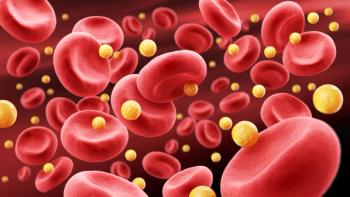
Treatment With Atrasentan Improves Albuminuria in Patients With Chronic Kidney Disease, Diabetes
Atrasentan has been found to lower albuminuria, which correlates with reductions in low-density lipoprotein cholesterol and triglycerides.
Treatment with atrasentan was found to produce a meaningful decrease across various cardiovascular data points among patients with type 2 diabetes and chronic kidney disease (CKD), according to a phase 2 study presented at the recent 2022 American Society of Nephrology Annual Meeting.
The researchers evaluated whether atrasentan therapy to lower albuminuria and lipids also reduces proprotein convertase subtilisin kexin type 9 (PCSK9), and/or syndecan-1 shedding. Atrasentan, an endothelin receptor antagonist, has been found to reduce albuminuria and correlates with reductions in low-density lipoprotein (LDL) cholesterol and triglycerides.
Previous research shows albuminuria can increase PCSK9, syndecan-1 shedding, and/or PCSK9-syndecan-1 interaction, which may impair clearance of hepatic lipoprotein. For the study, the authors randomized patients with type 2 diabetes and CKD to receive either atrasentam 0.75 mg daily or 1.25 mg daily (n = 94) or placebo (n = 26) for 12 weeks.
Each patient was stabilized to a maximum labeled dose of renin-angiotensin-aldosterone system (RAAS) inhibitors. The investigators analyzed urine albumin creatinine ratio (UACR), serum lipids, PCSK9, and syndecan-1 at baseline and week 12.
The study authors found that treatment with atrasentan lowered UACR by 37.1% (95% CI, 30.1-43.4; P <0.01). The drug also produced decreases in LDL cholesterol levels by 17.12 mg/dL (95%CI, 8.8-25.4; P <0.01), triglycerides by 47.4 mg/dL (95% CI, 40.4-90.5; P <0.01), and PCSK9 by -25.9 ng/mL (95% CI, -52.7 to 1.0 (P = 0.061) vs the placebo.
Further, the investigators did not find any effects on high-density lipoprotein cholesterol and syndecan-1. Following a multivariate analysis that was adjusted for baseline demographics, lipid, and kidney function parameters, the study authors found that achieved albuminuria levels with astratean treatment was associated with achieved PCSK9 levels (β 0.00227 per unit increment in PCSK9; P = 0.0094).
“In patients with type 2 diabetes and CKD, atrasentan reduces albuminuria, LDL [cholesterol] and triglycerides. At 12 weeks of atrasentan treatment, achieved albuminuria correlated with achieved PCSK9,” the study authors wrote. “Our study might suggest a mechanism by which atrasentan provides cardio-protection in high-risk patients with type 2 diabetes and CKD.”
These results were similar to a 2019 study published in
“Atrasentan reduced the risk of renal events in patients with diabetes and chronic kidney disease who were selected to optimize efficacy and safety,” the study authors wrote. “These data support a potential role for selective endothelin receptor antagonists in protecting renal function in patients with type 2 diabetes at high risk of developing end-stage kidney disease.”
Newsletter
Stay informed on drug updates, treatment guidelines, and pharmacy practice trends—subscribe to Pharmacy Times for weekly clinical insights.


















































































































































































































